Pepsinogen II (PGII) Assay Kit (Magnetic Particle Chemiluminescence)
- FOB Price:Get Latest Price >
- Min.Order:1 Box(es)
- Payment Terms:T/T , PayPal
- Favorite
Business Type:Manufacturer
Country/Region:China
Ddu Verified
HOT Rank


Biochip Langdao (Tianjin)Medical Technology Limited
We are professional supplier of Nasal filter & allergy blocker,Clite-160i Analyzer,Serumamyloid A (SAA) Assay Kit,Gastrin 17 (G17) Assay Kit,Myoglobin (Myo) Assay Kit,Pepsinogen I (PGI) Assay Kit,Peps
Business Type:Manufacturer
Country/Region:China
Ddu Verified
HOT Rank

1.Product Overview
[product name] : Pepsinogen II(PGII)
[Package Specification] :30 tests/kit;60 tests/kit
[Applicable Device] : CLite-160i
[Specimen Type] : serum
[Storage] : 2-8℃
[Product validity] : 12 months
[Detection method] : magnetic particle chemiluminescence method
2.technique principle
Double antibody sandwich method was used in the kit. The detection principle is: the sample to be tested, R1 reagent, R2 reagent and M reagent are mixed for incubation, and the fluorescein (FITC) labeled PGII antibody 1 in R1 reagent and the alkaline phosphatase (ALP) labeled PGII antibody 2 in R2 reagent are combined with the PGII antigen molecules in the sample to form an immune complex. The immune complex is further captured by anti-FITC antibodies coupled to the surface of the magnetic particle and adsorbed to the surface of the magnetic particle. After washing, the unbound material was removed and the luminescent substrate was added, ALP catalyzed the luminescence of the substrate, and the relative luminescence intensity (RLU) was determined
3.The clinical significance
Pepsinogen II(PGII)is another precursor of pepsin produced by the chief cells within the gastric mucosa, which upon exposure to acidic conditions gets converted into pepsin to aid in the digestion of proteins. The clinical significance of Pepsinogen II primarily includes:
(1. Assessment of Gastric Mucosal Functionality: Serum levels of Pepsinogen II offer insight into the activity and functional state of the chief cells in the stomach. Lowered levels could signify atrophy or dysfunction of the gastric mucosa, such as in chronic atrophic gastritis.
(2. Screening for Gastric Cancer Risk: Particularly when looking at the ratio of Pepsinogen II to Pepsinogen I, testing for Pepsinogen II content is employed in certain regions as part of gastric cancer risk assessment protocols; an increased ratio is often regarded as a warning sign for potential gastric cancer.
(3. Differential Diagnosis: Values of Pepsinogen II contribute to distinguishing among various gastric pathologies like peptic ulcers, gastritis, and gastric cancer.
(4. Monitoring Therapeutic Response: By tracking changes in Pepsinogen II levels, physicians can assess the efficacy of therapies targeting gastric mucosa-related issues and make necessary adjustments to treatment regimens.
(5. Evaluating Extent of Gastric Atrophy: Declines in Pepsinogen II correspond generally with the extent of gastric mucosal atrophy, making it a valuable biomarker for grading the severity of atrophic gastritis.
(6. Longitudinal Health Surveillance: Individuals with a personal or familial history of gastric cancer stand to benefit from regular check-ups that include Pepsinogen II measurements—this facilitates proactive management over time.
(7. Complementing Additional Biomarkers: Pepsinogen II is commonly analyzed together with Pepsinogen I, yielding a critical ratio (PG I/PG II) that significantly impacts the evaluation of gastric mucosal health.
In essence, the analysis of Pepsinogen II is a key component in assessing gastric wellbeing, but must be combined with additional diagnostics and clinical data for accurate interpretations. In every case, the interpretation and ensuing handling of Pepsinogen II test results ought to occur under the supervision of medical professionals.
4.Product features and indicators
High sensitivity: the detection limit is not higher than1.4ng/mL;
Wide linear range: samples in the range of1.4~100.0 (ng/mL) do not need to be diluted;
Good correlation: c correlation R > 0.95 with Biohit reagent;
Good stability: the calibration cycle can be up to 14 days, and the reagent can be stored at 4℃ for 1 year;
Fast results: only 16-18 minutes to get results.